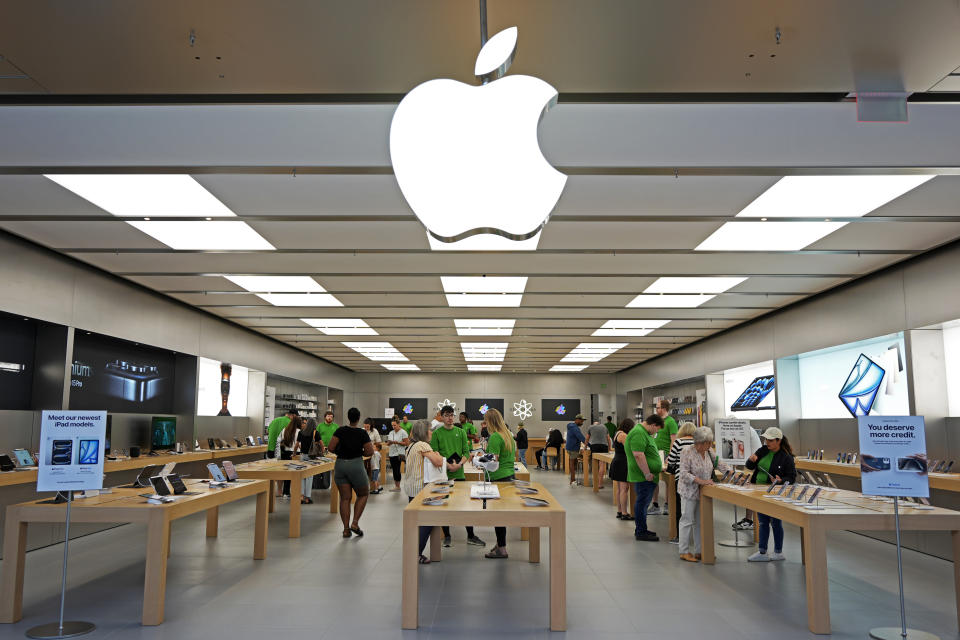Why Apple’s generative AI push won’t launch an iPhone supercycle in 2024

We’re less than a week out from Apple’s (AAPL) Worldwide Developers Conference (WWDC), which kicks off on June 10 at the company’s headquarters in Cupertino, Calif. This year the company is expected to unveil its big generative AI push with new capabilities for the iPhone.
The moves are likely to energize investors who have been anxiously awaiting Apple’s foray into generative AI. But don’t expect generative AI itself to spur a new iPhone sales supercycle this year. That’s because when it comes to smartphones, users care more about hardware than software.
“I don’t think it’s going to become the primary reason why people buy an iPhone,” explained Thomas Husson, vice president and principal analyst at Forrester. “It’s more likely going to augment experiences.”
But that doesn’t mean generative AI won’t power iPhone sales in the coming years. That’s because as phones age and become unable to run generative AI experiences, users will inevitably have to upgrade.
It’s all about the hardware… at first
People generally buy new smartphones for the hardware, not software.
“The typical consumer is not going to care [about generative AI],” explained Deepwater Asset Management managing partner Gene Munster. “They want to know screen size, No. 1. Second is camera, third is battery.”
There’s another reason generative AI on the iPhone is unlikely to get people to line up outside of their local Apple Store: The software is still too new.
Many of the consumer offerings out there are still relatively basic. Microsoft’s (MSFT) Copilot will soon provide helpful tips on how to fix common PC issues, and Google’s (GOOG, GOOGL) Gemini for Workspace makes drafting emails easier. But by and large, there’s no must-have generative AI app.
Even Microsoft’s AI-centric Copilot+ PCs are more interesting for their new Qualcomm (QCOM) chips, which are supposed to rival Apple’s own M3 processors, than for the AI software they’re named after.

“If you go to Joe and Jane Smith on Main Street, USA, and say to them, ‘Hey, you can have Gen AI in your iPhone,’ now they’re going to say, ‘Great. Now, what do I do with it?’ And that’s the … intersection that we find ourselves at right now,” explained IDC research director Ramon Llamas.
According to Bloomberg reporter Mark Gurman, Apple will roll out a new, smarter version of Siri that will allow you to control apps with your voice and transcribe recordings, new photo editing tools, and enhanced notifications all powered by generative AI.
Sure, making Siri useful would be a huge step in the right direction, though it will be interesting to see how often people end up using the voice assistant. After all, when was the last time you asked Siri to do anything other than set a cooking timer or find out the weather for the next day?
Transcription and photo editing tools would also be helpful, but Google and Samsung already offer those features in their own phones, and they don’t seem to be driving sales. And it’s likely Apple will also offer its own take on transcription and photo apps too.
More importantly, we’ll have to wait to see how iPhone developers end up using generative AI technologies to improve their own third-party apps. Think about it. You likely spend most of your time on your iPhone using third-party apps like WhatsApp, TikTok, or Gmail. The same will be true with generative AI-powered apps, but it’ll take time for developers to get them up and running.
Sales will come
While generative AI might not kick off a sales bonanza this year, it will get consumers to pony up for new iPhones in the coming years. That’s because generative AI features will require some of Apple’s latest chips, and users with older phones will either be unable to use those functions or they’ll run slowly. And nothing gets people to want to buy a new phone than when apps are slow.
“It’ll take six months, a year, two, three years, for people to start to understand that the hardware that they had pre-generative AI isn’t performing as well as your phone,” Munster said. “The battery won’t last, because it will be putting more weight on the CPU or the AI chip … things like that. I think that this iPhone AI upgrade cycle, it’s like a two- or three-year cycle.”
That’s not to say Apple might not see a sales bump in September when it releases its next iPhone. The smartphone market, in general, is starting to turn around after a two-year slog. According to IDC, global smartphone sales should improve by 4% year over year in 2024. The majority of that, however, will come from Android sales, though iPhone shipments should improve some 0.7%. Not exactly a staggering number, but an increase, nonetheless.
As for the sales boost, that’s more likely to come further down the line as Apple fine-tunes its generative AI features and developers fire off more generative AI-powered apps that tax older iPhones. As for the supercycle, it’ll just have to wait.
Email Daniel Howley at dhowley@yahoofinance.com. Follow him on Twitter at @DanielHowley.
Click here for the latest technology news that will impact the stock market.
Read the latest financial and business news from Yahoo Finance




